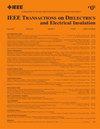Fault Feature Assessment Method for High-Voltage Circuit Breakers Based on Explainable Image Recognition
IF 3.1
3区 工程技术
Q2 ENGINEERING, ELECTRICAL & ELECTRONIC
IEEE Transactions on Dielectrics and Electrical Insulation
Pub Date : 2024-10-29
DOI:10.1109/TDEI.2024.3487820
引用次数: 0
Abstract
The current deep learning (DL) model for fault diagnosis of high-voltage circuit breakers (HVCBs) lacks explainability. It is difficult to further analyze the cause and mechanism of faults, which could provide little help for the maintenance and optimization design of HVCBs. To address this problem, a fault feature assessment method of HVCBs based on explainable image recognition is proposed to realize a quantitative analysis of faults. First, the vibration signals of HVCBs are preprocessed by continuous wavelet transform (CWT). The time-frequency diagrams of CWT are segmented by the travel curve to obtain the action sequence of the HVCB. Then, Shapley additive explanations (SHAPs) explain the deep residual network ResNet to obtain the feature importance distribution maps. Through the feature importance distribution map, accurate fault location and time traceability can be realized, and the frequency-domain features of the fault can be directly visualized from the distribution degree of the feature importance. The fault evaluation factor (FEF) is proposed to quantitatively study the time-frequency–amplitude comprehensive difference between the fault state and the normal state of the circuit breaker.基于可解释图像识别的高压断路器故障特征评估方法
目前用于高压断路器故障诊断的深度学习(DL)模型缺乏可解释性。进一步分析故障的原因和机理比较困难,对高压断路器的维护和优化设计帮助不大。针对这一问题,提出了一种基于可解释图像识别的高压断路器故障特征评估方法,实现了故障的定量分析。首先,对高压断路器的振动信号进行连续小波变换预处理。利用行程曲线对CWT的时频图进行分割,得到高压断路器的动作序列。然后,Shapley加性解释(SHAPs)对深度残差网络ResNet进行解释,得到特征重要性分布图。通过特征重要度分布图,可以实现准确的故障定位和时间追溯,并可以从特征重要度的分布程度直接可视化故障的频域特征。为了定量研究断路器故障状态与正常状态的时频幅综合差,提出了故障评价因子(FEF)。
本文章由计算机程序翻译,如有差异,请以英文原文为准。
求助全文
约1分钟内获得全文
求助全文
来源期刊
CiteScore
6.00
自引率
22.60%
发文量
309
审稿时长
5.2 months
期刊介绍:
Topics that are concerned with dielectric phenomena and measurements, with development and characterization of gaseous, vacuum, liquid and solid electrical insulating materials and systems; and with utilization of these materials in circuits and systems under condition of use.

 求助内容:
求助内容: 应助结果提醒方式:
应助结果提醒方式:


